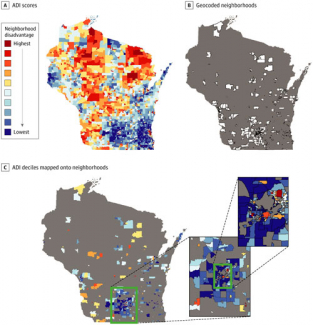
A new study finds neighborhood disadvantage may negatively impact the brain in middle to older age.
The study “Neighborhood disadvantage is associated with cerebral and hippocampal volume,” was published in the Journal of the American Medical Association Neurology. The study was led by Barbara Bendlin, PhD, and Amy Kind, MD, PhD, associate professors of medicine (geriatrics), and Jack Hunt, a dual MD/PhD student in the Medical Scientist Training Program in the University of Wisconsin School of Medicine and Public Health.
The study looked at hippocampal (the center of the brain’s emotional and memory system) and total brain volumes of 951 cognitively normal individuals. Results show that participants from the most highly disadvantaged neighborhoods had smaller hippocampal areas (4% lower) compared to participants in more advantaged neighborhoods. According to the study, that 4% is the equivalent of four to seven extra years of brain aging.
Neighborhood disadvantage is a fundamental social determinant of health, and directly reflects the poverty, unemployment, education, and housing quality in a precise geographic area. The researchers defined the socioeconomic status of neighborhoods using the Neighborhood Atlas tool developed by Dr. Kind.
“This research is among the first to demonstrate that the relative disadvantage of our neighborhoods is linked to brain structures involved in memory function,” said Hunt, a researcher in the Bendlin lab at the Wisconsin Alzheimer’s Disease Research Center (ADRC) and first author of the study.
The participants in the study were enrolled in the Wisconsin Alzheimer’s Disease Research Center (ADRC) Clinical Core and the Wisconsin Registry for Alzheimer’s Prevention (WRAP) study. The Clinical Core is a group of nearly 1,000 people with and without memory loss who volunteer for studies designed to investigate factors related to Alzheimer’s disease, and WRAP is one of the world’s largest and longest running studies of individuals at risk for Alzheimer’s disease. Participants from both cohorts are followed over time so researchers can learn about biological, health, and lifestyle factors that may be associated with the disease.
The participants had MRIs to measure the hippocampal and total brain volume. The Neighborhood Atlas employs the Area Deprivation Index, a measure created by the Health Resources and Services Administration, refined for present day use by Dr. Kind and her group and based on U.S. Census Bureau American Community Survey data.
Researchers note that the relation of neighborhood disadvantage and brain structure was not due to differences in racial identity or years of education in the participants from the most disadvantaged areas. Cardiovascular risk factors like high blood pressure and diabetes mediated the association for total brain tissue but not hippocampal volume, suggesting neighborhood disadvantage may be associated with multiple, distinct pathways that affect brain health.
“In the future, researchers and clinicians might be able to use technology like that used in our study to identify factors that negatively impact brain health on a population level,” said Dr. Kind, Wisconsin ADRC Core Leader and study co-author. “The same technology could then help direct preventive strategies like improving access to affordable healthcare, housing, nutritious foods, community activities, or caregiver support to the individuals and communities that need them most.”
According to the Centers for Disease Control and Prevention, as many as 5 million Americans are living with Alzheimer’s disease and that number is projected to triple to 14 million by 2060. It is the sixth leading cause of death and the only one in the top 10 with no way to slow or cure the disease.
Story by Tyler Fox
- Log in to post comments



